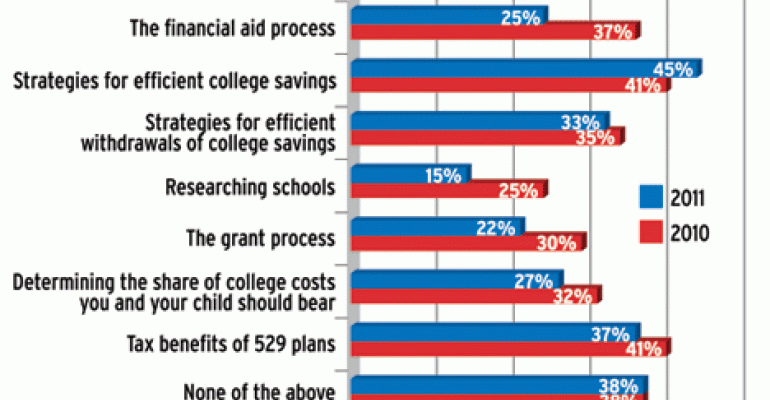Assets in college-targeted 529 savings plans are growing at double-digit rates, but financial advisors appear to be on the sidelines when it comes to working with clients on the product, a new report by Fidelity Investments suggests. In only 38 percent of cases where clients work with advisors and buy 529 plans do the advisors proactively suggest doing so; parents “continue to drive the discussion,” says Fidelity’s fifth annual College Savings Indicator.
“So I think there’s room for advisors to do better with their clients,” says Matt Golden, vice president of college savings at Fidelity. Part of the reason is parents are saving sooner for college, so the issue is on the top of their minds, Golden says; 40 percent of parents with preschool-age children have started saving for college in a dedicated account, up from 27 percent in 2007, the report says. “But it may not be top of mind for the advisor, because this may not be a big dollar amount to start with,” Golden says.
Financial Research Corp. in Boston reports the average 529 plan had $14,000 at mid-2011. Interest among investors is growing, however. Total assets at midyear nationally stood at $150 billion, up more than 27 percent from a year earlier, says Paul Curley, FRC’s director of college savings. FRC has estimated that the figure could go to $247 billion in 2014. “Investors are making college savings a priority,” he says. “Tuition inflation didn’t slow down in the more recent market turbulence.”
Interest in 529s nothwithstanding, investors are having a hard time staying ahead of college-cost inflation, Fidelity’s report says. It estimates those costs have risen 26 percent in the last five years. Meanwhile, the percentage of college costs that families expect to cover for college has fallen in the past five years, the survey says, from 24 percent in 2007 to 16 percent this year. (The 2011 figure is flat from 2010.) The trend holds even with families that use financial advisors, although they’re still better positioned than those families that do not. Among families that use advisors, 31 percent of college costs are projected to be covered, up from 28 percent last year but down sharply from 47 percent in 2007.
Golden says the segment of the population using advisors tends to be more affluent. “But those numbers don’t lie,” he adds. “Those parents that are working with advisors seem to be in a better position, or better prepared.” Most parents—62 percent—say they’re closer to achieving their college savings goals with an advisor than without. Sixty-one percent of parents who work with advisors are saving systematically for college bills, compared to 51 percent who are saving systematically but not working with advisors. And more families are turning to advisors for help in planning for college. Fidelity says 33 percent are doing so now, compared to 21 percent five years ago.
The survey, performed online by Research Data Technology, polled 2,400 families with children age 18 and younger. Annual household income was at least $30,000, with average household income totaling $82,500.
One thing that can ease parents’ minds about covering those costs: College savings are unlikely to affect financial aid, according to college consultant Lynn O’Shaughnessy, who writes for Registered Rep. on the topic. She says that less than 4 percent of families have put enough money away to affect a financial aid award. The formulas that calculate financial need don’t take qualified retirement savings into account, she adds, and may not include home equity either. Even wealthy students may qualify for merit awards, O’Shaughnessy adds, although not always.
Few people know the ins and outs of college financing, she says, and advisors have few financial incentives to learn. “It’s very rare to find advisors who really understand how college and financial aid work. I think it’s horrible, but that’s the way it is.”
Here’s a breakdown from Fidelity on what areas advisors are working with clients concerning college spending:






